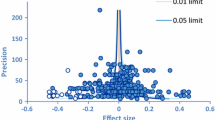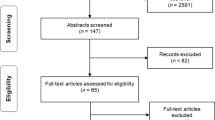Abstract
Many intervention programs, including physical activity programs, have been developed to deal with youth involvement in delinquency. The current study explored whether youth participation in sport and physical activity programs reduces their involvement in delinquent behaviors. It examined the interaction effects of the features of the sports program with participation in the sports program. The sample consisted of 126 Israeli adolescents aged 13–18 (M = 15.68, SD = 1.32) who completed questionnaires about involvement in delinquency at the beginning of their sports program and again 6 months later. We found significant reductions in adolescents’ involvement in all the delinquent acts explored: crimes against a person; crimes against property, and public disorder crimes. However, no interaction effects were found between program features (sport type; program intensity; training and supervision in the program; and interaction with community services) and participation in the sports program. The findings highlight the importance of including sports programs in the interventions provided for at-risk youth and call for further investigation of the factors that may increase the benefits provided by participation in physical activity programs.
Similar content being viewed by others
References
Amodei, N., & Scott, A. A. (2002). Psychologists’ contribution to the prevention of youth violence. The Social Science Journal, 39, 511–526.
Andrews, J. P., & Andrews, G. J. (2003). Life in a secure unit: The rehabilitation of young people through the use of sport. Social Science & Medicine, 56, 531–550.
Armour, K., Sandford, R., & Duncombe, R. (2013). Positive youth development and physical activity/sport interventions: Mechanisms leading to sustained impact. Physical Education and Sport Pedagogy, 18, 256–281.
Bailey, R. (2006). Physical education and sport in schools: A review of benefits and outcomes. Journal of School Health, 76, 397–401.
Begg, D. J., Langley, J. D., Moffitt, T., & Marshall, S. W. (1996). Sport and delinquency: An examination of the deterrence hypothesis in a longitudinal study. British Journal of Sports Medicine, 30, 335–341.
Biddle, S. (2006). Defining and measuring indicators of psycho-social well- being in youth sport and physical activity. In Y. Vanden-Auweele, C. Malcom & B. Meulders (Eds.), Sports and development (pp. 163–184). Teuven: Lannoo Campus.
Burton, J. M., & Marshall, L. A. (2005). Protective factors for youth considered at risk of criminal behaviour: Does participation in extracurricular activities help? Criminal Behaviour and Mental Health, 15, 46–64.
Carmichael, D. (2008). Youth sport vs. youth crime. Brockville, ON: Active Heathy Links.
Coie, J. D., Lochman, J. E., Terry, R., & Hyman, C. (1992). Predicting early adolescent disorder from childhood aggression and peer rejection. Journal of Consulting and Clinical Psychology, 60, 783–792.
Côté, J., & Gilbert, W. (2009). An integrative definition of coaching effectiveness and expertise. International Journal of Sports Science & Coaching, 4, 307–323..
Crosnoe, R. (2001). The social world of male and female athletes in high school. In D. A. Kinney (Ed.), Sociological studies of children and youth (pp. 89–110). Bingley: Emerald Group Publishing..
Danish, S. J. (2002). Teaching life skills through sport. In M. Gatz, M. A. Messner & S. J. Ball-Rokeach (Eds.), Paradoxes of youth and sport (pp. 49–59). Albany, NY: State University of New York Press.
Danish, S. J., Taylor, T. E., & Fazio, R. J. (2003). Enhancing adolescent development through sports and leisure. Blackwell Handbook of Adolescence, 12, 92–108..
Davis, B. S., & Menard, S. (2013). Long term impact of youth sports participation on illegal behavior. The Social Science Journal, 50, 34–44..
Donaldson, S. J., & Ronan, K. R. (2006). The effect of sports participation on young adolescents’ well-being. Adolescence, 41, 370–389.
Eley, D., & Kirk, D. (2002). Developing citizenship through sport: The impact of a sport-based volunteer programme on young sport leaders. Sport, Education and Society, 7, 151–166..
Elliott, D. S., & Ageton, S. S. (1980). Reconciling race and class differences in self-reported and official estimates of delinquency. American Sociological Review, 45, 95–110.
Endresen, I. M., & Olweus, D. (2005). Participation in power sports and antisocial involvement in preadolescent and adolescent boys. Journal of Child Psychology and Psychiatry, 46, 468–478.
Farineau, H. M., & McWey, L. M. (2011). The relationship between extracurricular activities and delinquency of adolescents in foster care. Children and Youth Services Review, 33, 963–968.
Foshee, V. A., Gottfredson, N. C., Reyes, H. L. M., Chen, M. S., David-Ferdon, C., Latzman, N. E., Tharp, A. T., & Ennett, S. T. (2016). Developmental outcomes ofusing physical violence against dates and peers. Journal of Adolescent Health, 58, 665–671.
France, A., Sutton, L., Sandu, A., & Waring, A. (2007). Making a positive contribution: The implications for youth work of Every Child Matters. The National Youth Agency Research Programme Series. Retrieved June 15, 2010, from http://www.crsp.ac.uk/downloads/publications/alans_publications/making_a_positive_contribution.pdf.
Fredricks, J. A., & Eccles, J. S. (2006). Is extracurricular participation associated with beneficial outcomes? Concurrent and longitudinal relations. Developmental Psychology, 42, 698–713.
Gass, M. A., & Priest, S. (1997). Effective leadership in adventure programming. Champaign, IL: Human Kinetics.
Hans, T. A. (2000). A meta-analysis of the effects of adventure programming on the locus of control. Journal of Contemporary Psychotherapy, 30, 33–60.
Hirschi, T. (1969). Causes of delinquency. Berkeley: University of California Press.
Khoury-Kassabri, M., Khoury, N., & Ali, R. (2015). Arab youth involvement in delinquency and political violence and parental control: The mediating role of religiosity. American Journal of Orthopsychiatry, 85, 576–585.
Kravets-Fenner, Y., Khoury-Kassabri, M., Aszenstadt, M., & Amedi, S. (2013). Risk factors for delinquency and anti-social behavior among adolescents treated by the Division of At-Risk Youth. Journal of Welfare and Society, 33, 41–70 (Hebrew).
Kreager, D. A. (2007). Unnecessary roughness? School sports, peer networks, and male adolescent violence. American Sociological Review, 72, 705–724.
Langbein, L., & Bess, R. (2002). Sports in school: Source of amity or antipathy? Social Science Quarterly, 83, 436–454.
Larson, A., & Silverman, S. J. (2005). Rationales and practices used by caring physical education teachers. Sport, Education and Society, 10, 175–193.
Limbos, M. A., Chan, L. S., Warf, C., Schneir, A., Iverson, E., Shekelle, P., & Kipke, M. D. (2007). Effectiveness of interventions to prevent youth violence: A systematic review. American Journal of Preventive Medicine, 33, 65–74.
Makkai, T., Morris, L., Sallybanks, J., & Willis, K. (2003). Sport, physical activity and antisocial behaviour in youth. Canberra: Australian Institute of Criminology..
McKenney, A. (2001). Sport as a context for teaching prosocial behavior to adolescents with disruptive behavior disorders. Retrieved October 20, 2017, from http://www.lin.ca.
McMahon, S. D., & Washburn, J. J. (2003). Violence prevention: An evaluation of program effects with urban African American students. The Journal of Primary Prevention, 24, 43–62.
Morris, L., Sallybanks, J., Willis, K., & Makkai, T. (2004). Sport, physical activity and antisocial behavior in youth. Youth Studies Australia, 23, 47–62.
Nichols, G. (1997). A consideration of why active participation in sport and leisure might reduce criminal behaviour. Sport, Education and Society, 2, 181–190.
Poinsett, A. (1996). The role of sports in young development. New York: Carnegie Corporation.
Rhea, D. J., & Lantz, C. D. (2004). Violent, delinquent, and aggressive behaviors of rural high school athletes and non-athletes. Physical Educator, 61, 170–176.
Russell, I. M. (2005). A national framework for youth action and engagement. London: HMSO.
Sandford, R. A., Armour, K. M., & Duncombe, R. (2007). Physical activity and personal/social development for disaffected youth in the UK: In search of evidence. In N. Holt (Ed.), Positive youth development through sport (pp. 97–109). London: Routledge.
Sandford, R. A., Armour, K. M., & Warmington, P. C. (2006). Re-engaging disaffected youth through physical activity programmes. British Educational Research Journal, 32, 251–271.
Sandford, R. A., Duncombe, R., & Armour, K. M. (2008). The role of physical activity/sport in tackling youth disaffection and anti-social behaviour. Educational Review, 60(4), 419–435.
Schmid, H. (2007). Children and youth at risk in Israel: Findings and recommendations to improve their wellbeing. Children and Youth Services Review, 29(8), 1114–1128.
Schneider, A., & Shoham, L. (2017). Informal education in Israel’s Arab society: From an overlooked field to a government priority. Inter-Agency Task Force on Israeli Arab Issues.
Slavin, M., Pilver, C. E., Hoff, R. A., Krishnan-Sarin, S., Steinberg, M. A., Rugle, L., & Potenza, M. (2013). Serious physical fighting and gambling related attitudes and behaviors in adolescents. Journal of Behavioral Addictions, 2, 167–178.
Smith, R. E., & Smoll, F. L. (1991). Behavioral research and intervention in youth sports. Behavior Therapy, 22, 329–344.
Spruit, A., van der Put, C., van Vugt, E., & Stams, G. J. (2017). Predictors of intervention success in a sports-based program for adolescents at risk of juvenile delinquency. International Journal of Offender Therapy and Comparative Criminology. https://doi.org/10.1177/0306624X17698055.
Spruit, A., Van Vugt, E., van der Put, C., van der Stouwe, T., & Stams, G. J. (2016). Sports participation and juvenile delinquency: A meta-analytic review. Journal of Youth and Adolescence, 45, 655–671.
Statland-Vaintraub, O., Khoury-Kassabri, M., Aszenstadt, M., & Amedi, S. (2012). Risk factors for involvement in delinquency among immigrants and native-born Israeli girls. Children and Youth Services Review, 34, 2052–2060.
Zionit, Y., & Kosher, H. (2013). Children in Israel - An annual statistical abstract. Jerusalem: Center for Research and Public Education, National Council for the Child. (Hebrew).
Acknowledgements
The authors would like to thank the many young people and program managers and coordinators who generously gave their time and support to make this study possible.
Author information
Authors and Affiliations
Corresponding author
Ethics declarations
Conflict of interest
The authors declare that they have no conflict of interest.
Ethical Approval
All procedures performed in studies involving human participants were in accordance with the ethical standards of the Hebrew University research committee and with the 1964 Helsinki declaration and its later amendments or comparable ethical standards.
Informed Consent
Informed consent was obtained from all individual participants included in the study.
Rights and permissions
About this article
Cite this article
Khoury-Kassabri, M., Schneider, H. The Relationship Between Israeli Youth Participation in Physical Activity Programs and Antisocial Behavior. Child Adolesc Soc Work J 35, 357–365 (2018). https://doi.org/10.1007/s10560-017-0528-y
Published:
Issue Date:
DOI: https://doi.org/10.1007/s10560-017-0528-y




